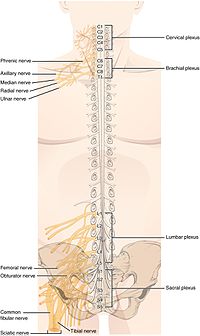Our website is made possible by displaying online advertisements to our visitors.
Please consider supporting us by disabling your ad blocker.
Nerve plexus
| Nerve plexus | |
|---|---|
 Superimposed image of the spinal plexuses on a human back. | |
| Identifiers | |
| TA2 | 6172 |
| FMA | 5901 |
| Anatomical terms of neuroanatomy | |
A nerve plexus is a plexus (branching network) of intersecting nerves.[1] A nerve plexus is composed of afferent and efferent fibers that arise from the merging of the anterior rami of spinal nerves and blood vessels. There are five spinal nerve plexuses, except in the thoracic region, as well as other forms of autonomic plexuses, many of which are a part of the enteric nervous system. The nerves that arise from the plexuses have both sensory and motor functions. These functions include muscle contraction, the maintenance of body coordination and control, and the reaction to sensations such as heat, cold, pain, and pressure. There are several plexuses in the body, including:
- Spinal plexuses
- Cervical plexus – serves the head, neck and shoulders
- Brachial plexus – serves the chest, shoulders, arms and hands
- Lumbosacral plexus
- Lumbar plexus – serves the back, abdomen, groin, thighs, knees, and calves
- Subsartorial plexus – below the sartorius muscle of thigh
- Sacral plexus – serves the pelvis, buttocks, genitals, thighs, calves, and feet
- Pudendal plexus
- Lumbar plexus – serves the back, abdomen, groin, thighs, knees, and calves
- Coccygeal plexus – serves a small region over the coccyx
- Autonomic plexuses
- Celiac plexus (solar plexus) – serves internal organs
- Auerbach's plexus (myenteric plexus) – serves the gastrointestinal tract
- Meissner's plexus (submucosal plexus) – serves the gastrointestinal tract
- Pharyngeal plexus of vagus nerve – serves the palate and pharynx
- Cardiac plexus – serves the heart
- ^ Betts, J Gordon; Desaix, Peter; Johnson, Eddie; Johnson, Jody E; Korol, Oksana; Kruse, Dean; Poe, Brandon; Wise, James; Womble, Mark D; Young, Kelly A (July 16, 2023). Anatomy & Physiology. Houston: OpenStax CNX. 13.4 The Peripheral Nervous System. ISBN 978-1-947172-04-3.
Previous Page Next Page


